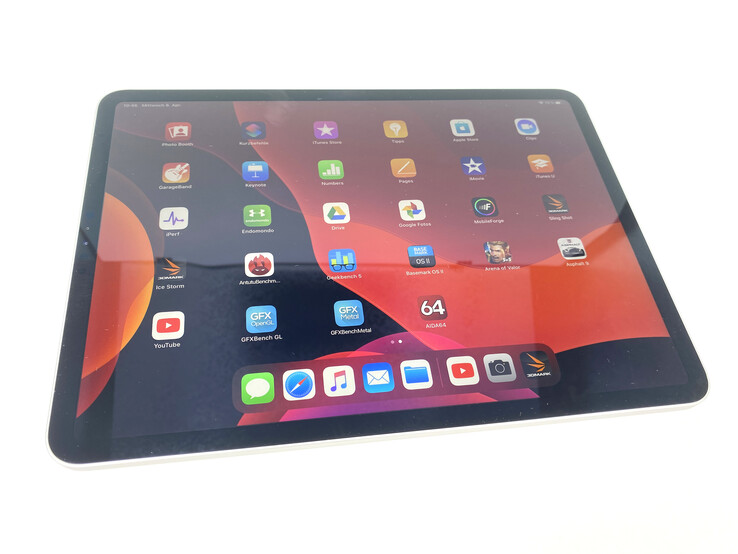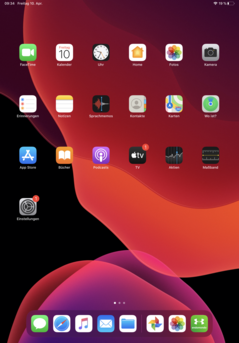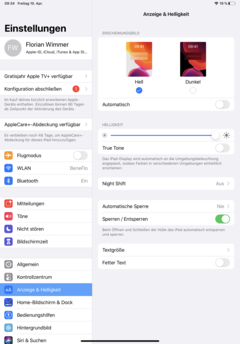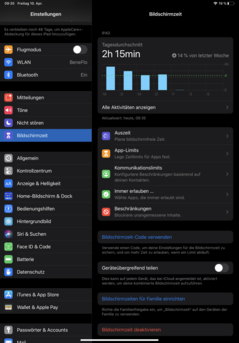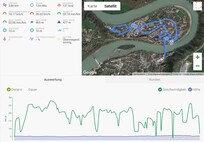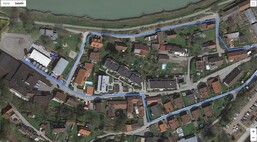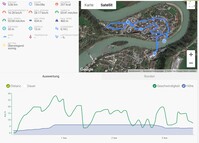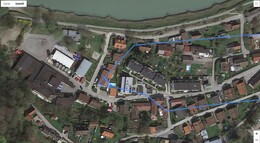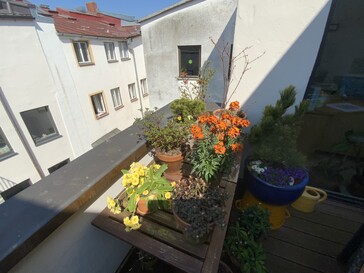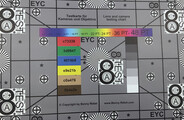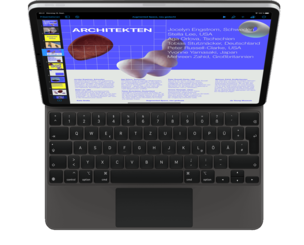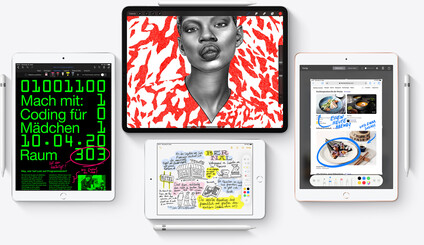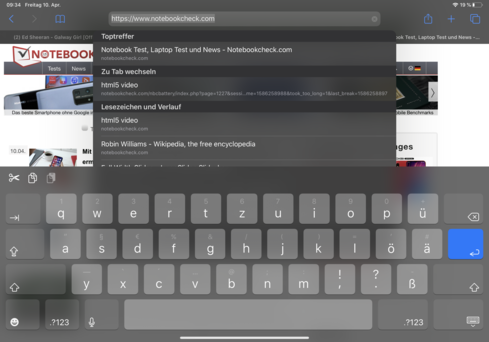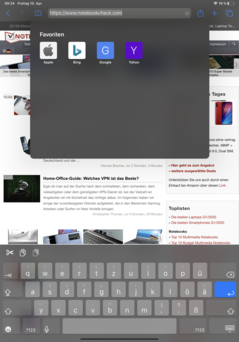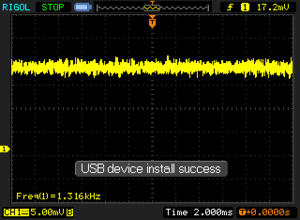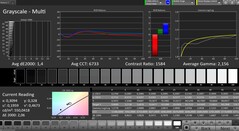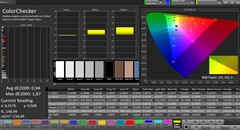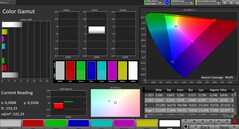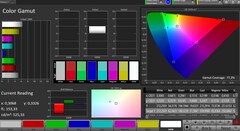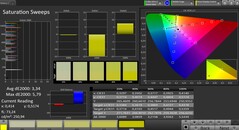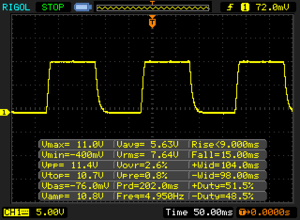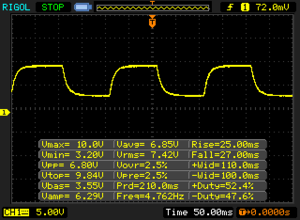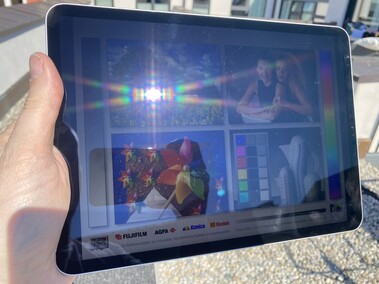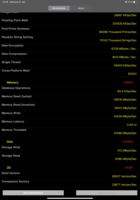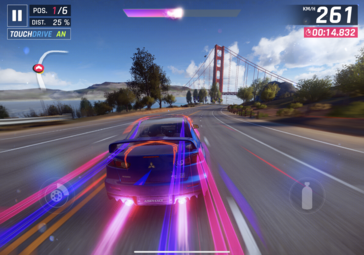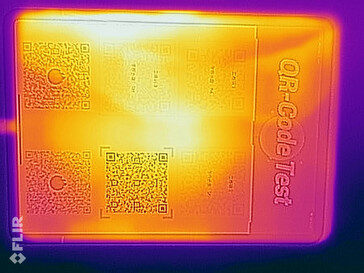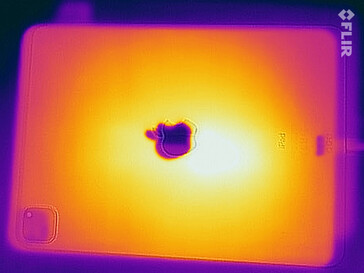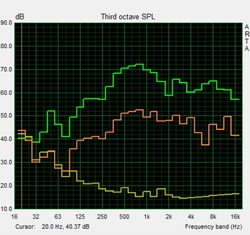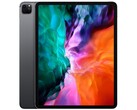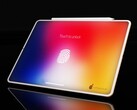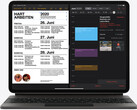Apple iPad Pro 11 2020 Tablet Review – This is what an update should look like

The iPad Pro as a laptop replacement: That is Apple's credo. The 2020 update comes with trackpad and mouse support as well as updated software, and Apple plans to release a new Keyboard Folio in May 2020.
In this review, we will take a look at the 11-inch version of the iPad Pro 2020. It comes with a new processor, the Apple A12Z, more RAM in some storage configurations and a 120-Hz display. Apple has also improved the cameras and since a few variants of the iPad Pro 2020 are also cheaper than their predecessors, the update looks like a great success at first glance.
In our review, we will of course dive deep into the iPad Pro to find out which users can benefit the most from the new Apple tablet.
Rating | Date | Model | Weight | Height | Size | Resolution | Price |
|---|---|---|---|---|---|---|---|
| 90.4 % v7 (old) | 04 / 2020 | Apple iPad Pro 11 2020 A12Z Bionic, A12Z Bionic GPU | 471 g | 5.9 mm | 11.00" | 2388x1668 | |
| 89.8 % v7 (old) | 11 / 2018 | Apple iPad Pro 11 2018 A12X Bionic, A12X Bionic GPU | 468 g | 5.9 mm | 11.00" | 2388x1668 | |
| 88.1 % v7 (old) | 02 / 2020 | Microsoft Surface Pro 7 i7-1065G7, Iris Plus Graphics G7 (Ice Lake 64 EU) | 790 g | 8.5 mm | 12.30" | 2736x1824 | |
| 87.8 % v7 (old) | 10 / 2019 | Samsung Galaxy Tab S6 SM-T860 SD 855, Adreno 640 | 420 g | 5.7 mm | 10.50" | 2560x1600 | |
| 83.4 % v7 (old) | 04 / 2018 | Huawei MediaPad M5 10.8 Kirin 960s, Mali-G71 MP8 | 498 g | 7.3 mm | 10.80" | 2560x1600 |
Case – Lightweight but Not Very Rigid
Aside from the different camera module, there are only a few changes in terms of the case design compared to the predecessor. This is not a bad thing, since the Apple iPad Pro 11 2018, which featured relatively slim bezels, a straightforward and somewhat angular design as well as subtle color themes, was already quite sleek.
Buyers have the choice between silver and space gray for colors and the dimensions remain unchanged. With an additional 3 grams, the weight difference is minor and inconsequential.
The fairly large camera module on the back has been placed in a convenient spot, which ensures that it does not get blocked in landscape mode and even improves the handling properties, since it is located directly above of the index finger when holding the device in landscape mode. Users will have to be careful not to block the front camera in landscape mode, however, since it is located in the center on the edge of the short side of the display. The display bezels have a good width for easy handling without accidental touchscreen presses.
The rigidity of the tablet is okay and while Microsoft's Surface Pro models are significantly more rigid, they are also heavier.
Features – Apple Tablet with a USB-C Port
Apple has one surprise in store when it comes to the pricing: Most configurations of the iPad Pro are cheaper or at least offer more storage for the same price. Furthermore, all iPad Pro 11 2020 models are equipped with 6 GB of RAM and the base model already offers 128 GB of internal storage, whereas the base model of the predecessor only offered half the storage. The following models are available:
- iPad Pro 11 Wi-Fi 128 GB / 6 GB RAM: 879 Euros ($799)
- iPad Pro 11 Wi-Fi+LTE 128 GB / 6 GB RAM: 1,049 Euros ($949)
- iPad Pro 11 Wi-Fi 256 GB / 6 GB RAM: 989 Euros ($899)
- iPad Pro 11 Wi-Fi+LTE 256 GB / 6 GB RAM: 1,159 Euros ($1,049)
- iPad Pro 11 Wi-Fi 512 GB / 6 GB RAM: 1,209 Euros ($1,099)
- iPad Pro 11 Wi-Fi+LTE 512 GB / 6 GB RAM: 1,379 Euros ($1,249)
- iPad Pro 11 Wi-Fi 1 TB / 6 GB RAM: 1,429 Euros ($1,299)
- iPad Pro 11 Wi-Fi+LTE 1 TB / 6 GB RAM: 1,599 Euros ($1,449)
The two 1-TB variants in particular are now 280 Euros (or ~$250) cheaper. This leads to a curious situation where in some online shops a few variants of the iPad Pro 11 2018 are more expensive than the newer device.
The USB-C port that can be used to transfer pictures or connect external screens to the iPad Pro is on board once again, which is an unusual choice for Apple. Fortunately, it is also compatible with accessories from other manufacturers such as, in our case, a USB-C adapter from Asus.
The 3-pin docking port on the back is still available and there is a magnetic connector for the Apple Pencil 2.
The iPad Pro 11 2020 is equipped with LIDAR sensors that are integrated into the camera module. They measure the time that light takes to travel to an object and use the results to gain a three-dimensional impression of a room. Apple also uses this for augmented reality applications.
Software – iPad OS on Board
The Apple iPad Pro 11 2020 ships with iPad OS, which can be found on most of the recent iPads. The user interface of the OS has been optimized for the larger displays, which is something iOS was unable to achieve on older devices. Another important factor is, of course, support for the iPad Pro's accessories such as the Keyboard Folio and Apple Pencil 2. The current version 13.4 now also comes with support for trackpads and thus the associated mouse cursor. A mouse can be connected to the iPad Pro as well.
According to the manufacturer, user data will be mixed with millions of other data sets for particularly well-protected privacy. Users of the Apple iPad Pro can also expect a fairly long update period, since the iPad Air 2 from 2014 still received an update to iPad OS last year.
Communication and GPS – iPad Pro with Fast Internet
Naturally, the iPad Pro comes with the latest Wi-Fi standard Wi-Fi 6, which according to our tests with our reference router Netgear Nighthawk AX12, it uses to an even greater effect than its predecessor. The fact that it goes head-to-head with other high-end tablets illustrates that the Wi-Fi transfer rates can match or even outperform even the fastest competitors.
In proximity to the router, the signal is at full strength, web pages load very quickly and images are loaded without delays. At a distance of 10 meters from the access point and through three walls, the signal strength is still at about 66% and while the loading times are then marginally higher, they are still very fast.
Our test device does not have built-in LTE and those who need it will pay a rather hefty premium of 170 Euros (or ~$150).
While there is no GPS module on our Wi-Fi model, it can use data from Wi-Fi networks in proximity and the compass to infer our position. Rudimentary navigation is thus possible and our bike ride shows that the approximate route is recorded, although the navigation often jumps back and forth, which means the tablet should only be used for rough position estimates.
Cameras – Tablet with a Zoom Camera
Tablet cameras are not useful for day-to-day life? This preconception has already been disproven by the iPad Pro 11 2018. Although Apple certainly does not use the same camera modules as for its current high-end smartphones, most users have no need for them in a tablet anyway. However, going back a few generations to the iPhone XR, the main lens of the iPad Pro 11 2020 has the same specifications: Here, Apple has installed a module with 12 megapixels and an optical image stabilizer. The second optics, an ultra-wide-angle lens with 10 megapixels, can capture an even wider field of view. The two comparison pictures below show the differences.
While the main camera has a fairly large field of view and takes well-brightened pictures with vivid colors, it cannot match current high-end smartphones, particularly when it comes to low-light situations. That being said, it does not have to compete with smartphone cameras and the pictures still look very good considering they were captured with a tablet. Zooming in and out between the two cameras in multiple steps is a smooth experience.
Videos can be captured at 4K and 60 frames per second, which is also a very high-quality standard for a tablet. Here, we also like the excellent brightening of the camera. Meanwhile, zooming out to the second optics is only possible when recording in Full HD quality.
The front camera has a resolution of 7 megapixels and also takes well-brightened pictures with details that exhibit a high degree of sharpness.
In our lab and under controlled lighting conditions, the main camera takes very sharp pictures with great colors, although barely anything in the image is still discernible in low-light situations.
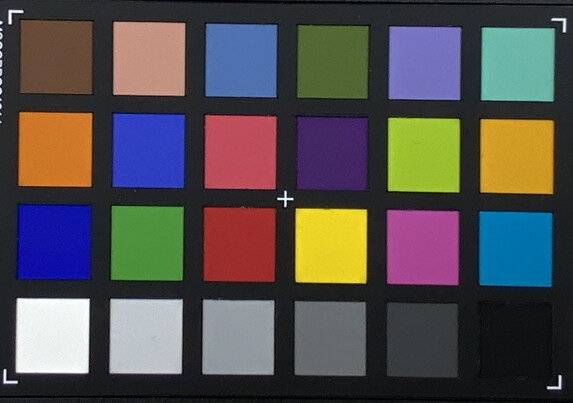
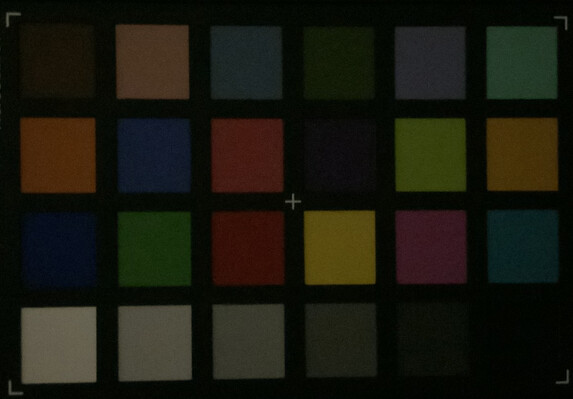
Accessories and Warranty – Wide Range of Options
The included charger remains unchanged and still has a USB-C output, while being able to deliver up to 18 watts of power, which means that existing accessories of the iPad Pro 11 2018 can still be used. Although Apple only offers a 12-month warranty, buyers in the EU are still protected by the retailer guarantee for an additional 12 months. Apple also offers AppleCare+ at a premium of 139 Euros (or $129), which protects users against accidental damages for two years and also encompasses the Apple Pencil if it is purchased. However, the service is limited to two repairs and demands an additional service fee.
The new Keyboard Folio with integrated touchpad is called Magic Keyboard and, according to Apple, will be released in May. Aside from the trackpad, which is now integrated, it offers a full keyboard with backlit keys. The cover has an integrated USB-C port that can be used to charge the iPad and the angle of the stand can be freely adjusted - the tablet then hovers above the keyboard. At 340 Euros ($299), its price matches that of its predecessor. Users who do not need a trackpad can purchase the Keyboard Folio for just below 200 Euros ($179) instead. Judging from past experience, third-party manufacturers usually offer a wide variety of keyboard covers and Bluetooth keyboards.
The Apple Pencil 2, which has its own magnetic mount on the side of the iPad, can be purchased for 135 Euros ($129). More information on this specific accessory can be found in our test of the Apple iPad Pro 11 2018. A Smart Folio without keyboard costs 89 Euros ($79). Furthermore, there are various adapters that will allow you to connect even more accessories to the USB-C port. However, Apple appears to meet the universal USB standard, and in our tests the iPad Pro worked well with other adapters and for example any USB mouse.
Input Devices & Handling – Super-smooth Touchscreen
Navigating the Apple tablet is an even smoother experience compared to the previous model thanks to the 120-Hz display. The touchscreen continues to be a joy to use by virtue of being very responsive and precise. In terms of hardware buttons, there is a volume rocker on the right side in portrait mode and a standby button on the top.
Naturally, FaceID is on board and unlocking the device with a previously stored face is fast and precise. Users will have to either press the standby button or activate the display by touching the touchscreen, just lifting the tablet to activate FaceID will not suffice. When using FaceID, users will have to be cautious not to block the front camera, otherwise FaceID will of course not work. There is no longer a fingerprint sensor on the iPad Pro 2020.
By contrast, the Apple Pencil 2 is still supported and not much has changed since the iPad Pro 11 2018, which means the pen continues to be a great additional tool for creators, although in our opinion, fingers are more practical for normal use.
While the onscreen keyboard is very intuitive, typists would be better served by one of Apple's external keyboard solutions such as the Keyboard Folio, which works well, although users with higher demands in terms of the typing experience should definitely consider the Magic Keyboard or a Bluetooth keyboard.
Display – 120 Hz Makes the Difference
Displays with high refresh rates are very popular in the realm of smartphones and for good reason: They are able to provide a smoother experience and improve the perceived smoothness during use. In this case, Apple has installed a 120-Hz display in its iPad Pro with all the popular Apple technologies: As with the predecessor, it is a Liquid Retina display with a native resolution of 2388x1668 pixels. True Tone adjusts the display's colors to the ambient lighting, which ensures that color tones always look the same.
The 120-Hz refresh rate aside, the display continues to uphold the high standard in terms of color reproduction of the previous model. Even compared to other tablets, the high brightness of the iPad Pro is still very respectable.
| |||||||||||||||||||||||||
Brightness Distribution: 84 %
Center on Battery: 617 cd/m²
Contrast: 1714:1 (Black: 0.36 cd/m²)
ΔE ColorChecker Calman: 0.94 | ∀{0.5-29.43 Ø4.77}
ΔE Greyscale Calman: 1.4 | ∀{0.09-98 Ø5}
99.9% sRGB (Calman 2D)
Gamma: 2.156
CCT: 6733 K
| Apple iPad Pro 11 2020 IPS, 2388x1668, 11" | Apple iPad Pro 11 2018 IPS, 2388x1668, 11" | Microsoft Surface Pro 7 IPS, 2736x1824, 12.3" | Samsung Galaxy Tab S6 SM-T860 Super AMOLED, 2560x1600, 10.5" | Huawei MediaPad M5 10.8 IPS, 2560x1600, 10.8" | |
|---|---|---|---|---|---|
| Screen | -8% | -11% | -79% | -76% | |
| Brightness middle (cd/m²) | 617 | 639 4% | 435 -29% | 446 -28% | 382 -38% |
| Brightness (cd/m²) | 585 | 591 1% | 422 -28% | 445 -24% | 378 -35% |
| Brightness Distribution (%) | 84 | 87 4% | 90 7% | 86 2% | 92 10% |
| Black Level * (cd/m²) | 0.36 | 0.45 -25% | 0.32 11% | 0.24 33% | |
| Contrast (:1) | 1714 | 1420 -17% | 1359 -21% | 1592 -7% | |
| Colorchecker dE 2000 * | 0.94 | 0.92 2% | 1.18 -26% | 2.7 -187% | 2.8 -198% |
| Colorchecker dE 2000 max. * | 1.87 | 2.59 -39% | 2.27 -21% | 5.4 -189% | 6 -221% |
| Greyscale dE 2000 * | 1.4 | 1.3 7% | 1.12 20% | 2.1 -50% | 3.5 -150% |
| Gamma | 2.156 102% | 2.22 99% | 2.3 96% | 2.05 107% | 2.33 94% |
| CCT | 6733 97% | 6656 98% | 6502 100% | 6468 100% | 6903 94% |
| Colorchecker dE 2000 calibrated * | 3.49 | ||||
| Color Space (Percent of AdobeRGB 1998) (%) | 60 | ||||
| Color Space (Percent of sRGB) (%) | 96 |
* ... smaller is better
Screen Flickering / PWM (Pulse-Width Modulation)
| Screen flickering / PWM detected | 1316 Hz | ||
The display backlight flickers at 1316 Hz (worst case, e.g., utilizing PWM) . The frequency of 1316 Hz is quite high, so most users sensitive to PWM should not notice any flickering. In comparison: 53 % of all tested devices do not use PWM to dim the display. If PWM was detected, an average of 8083 (minimum: 5 - maximum: 343500) Hz was measured. | |||
Our tests with the spectrophotometer and the software CalMAN confirm our first impression: Colors are reproduced very accurately, as is the grayscale. With the naked eye, a difference between the colors on the screen and a print is supposedly not noticeable. Thus, according to its own claim, the display of the iPad Pro is particularly well-suited to professional graphics work.
Display Response Times
| ↔ Response Time Black to White | ||
|---|---|---|
| 24 ms ... rise ↗ and fall ↘ combined | ↗ 9 ms rise | |
| ↘ 15 ms fall | ||
| The screen shows good response rates in our tests, but may be too slow for competitive gamers. In comparison, all tested devices range from 0.1 (minimum) to 240 (maximum) ms. » 53 % of all devices are better. This means that the measured response time is worse than the average of all tested devices (20.2 ms). | ||
| ↔ Response Time 50% Grey to 80% Grey | ||
| 52 ms ... rise ↗ and fall ↘ combined | ↗ 25 ms rise | |
| ↘ 27 ms fall | ||
| The screen shows slow response rates in our tests and will be unsatisfactory for gamers. In comparison, all tested devices range from 0.165 (minimum) to 636 (maximum) ms. » 88 % of all devices are better. This means that the measured response time is worse than the average of all tested devices (31.6 ms). | ||
The high brightness of the display also makes it suitable for outdoor use, although direct sunlight will make viewing the screen strenuous on the eyes. In the shade, working with the iPad Pro is a very good experience.
Similarly, the viewing angles warrant no criticism. Even if multiple people view the screen from different angles, they will see the same colors without haziness or distortions.
Performance – High-End
The new Apple A12Z Bionic is the SoC of choice. Even though Apple has not revealed any specifics, the differences compared to the A12X, which was used in the previous iPad Pro, are likely to be fairly minor. Only the thermal design appears to have been improved in order to enhance the performance of long-term workloads.
Our benchmarks indeed show the Apple iPad Pro 2020 to be faster than its predecessor by a few percent, making it significantly faster than the fastest current Android tablets. Demanding apps such as Photoshop were optimized specifically for the iPad Pro and since the latter now has 6 GB of RAM across all configurations, working with larger files should not be an issue.
Compared to the A12X, the GPU now has one more core and the iPad Pro continues to be very fast in terms of graphics performance.
Unfortunately, many benchmarks were not yet updated for iPad OS 13.4 and either crash or do not produce any results. Consequentially, we have not yet been able to test the iPad Pro 11 2020 as thoroughly as we would have liked. However, we will perform the benchmarks at a later date with new test samples, as soon as the compatibility issues have been fixed.
| 3DMark | |
| 1280x720 offscreen Ice Storm Unlimited Score | |
| Apple iPad Pro 11 2020 | |
| Average Apple A12Z Bionic (110582 - 110846, n=2) | |
| Samsung Galaxy Tab S6 SM-T860 | |
| Huawei MediaPad M5 10.8 | |
| 1280x720 offscreen Ice Storm Unlimited Graphics Score | |
| Apple iPad Pro 11 2020 | |
| Average Apple A12Z Bionic (220422 - 221941, n=2) | |
| Samsung Galaxy Tab S6 SM-T860 | |
| Huawei MediaPad M5 10.8 | |
| 1280x720 offscreen Ice Storm Unlimited Physics | |
| Average Apple A12Z Bionic (40279 - 40299, n=2) | |
| Apple iPad Pro 11 2020 | |
| Samsung Galaxy Tab S6 SM-T860 | |
| Huawei MediaPad M5 10.8 | |
| AnTuTu v8 - Total Score | |
| Average Apple A12Z Bionic (712218 - 751846, n=2) | |
| Apple iPad Pro 11 2020 | |
| Apple iPad Pro 11 2018 | |
| Basemark ES 3.1 / Metal - offscreen Overall Score | |
| Average Apple A12Z Bionic (5657 - 5709, n=2) | |
| Apple iPad Pro 11 2020 | |
| Apple iPad Pro 11 2018 | |
| Average of class Tablet (255 - 5784, n=9, last 2 years) | |
Web-browsing on the iPad Pro 11 2020 is a very snappy experience, there are barely any delays when viewing pictures and videos are loaded quickly as well.
| Jetstream 2 - 2.0 Total Score | |
| Average of class Tablet (23.3 - 395, n=68, last 2 years) | |
| Apple iPad Pro 11 2020 (Safari 14.1) | |
| Apple iPad Pro 11 2020 (Chrome 80) | |
| Average Apple A12Z Bionic (124.5 - 127.4, n=3) | |
| Samsung Galaxy Tab S6 SM-T860 (Chrome 77.0.3865.116) | |
| JetStream 1.1 - Total Score | |
| Apple iPad Pro 11 2018 (Safari 13) | |
| Apple iPad Pro 11 2020 (Chrome 80) | |
| Average Apple A12Z Bionic (272 - 274, n=2) | |
| Microsoft Surface Pro 7 (Microsoft Edge 44.18362.449.0) | |
| Samsung Galaxy Tab S6 SM-T860 (Chrome 77.0.3865.116) | |
| Huawei MediaPad M5 10.8 (Chrome 65) | |
| WebXPRT 3 - Overall | |
| Average of class Tablet (39 - 480, n=23, last 2 years) | |
| Apple iPad Pro 11 2020 (Safari 14.1) | |
| Apple iPad Pro 11 2020 (Chrome 80) | |
| Apple iPad Pro 11 2018 (Safari 13) | |
| Average Apple A12Z Bionic (140 - 194, n=3) | |
| Samsung Galaxy Tab S6 SM-T860 (Chrome 77.0.3865.116) | |
| Speedometer 2.0 - Result 2.0 | |
| Average of class Tablet (2.59 - 790, n=54, last 2 years) | |
| Apple iPad Pro 11 2020 (Safari 14.1) | |
| Average Apple A12Z Bionic (135 - 154, n=2) | |
| Apple iPad Pro 11 2018 (IOS 12.1.1) | |
| Samsung Galaxy Tab S6 SM-T860 (Chrome 77.0.3865.116) | |
| Octane V2 - Total Score | |
| Average of class Tablet (763 - 138481, n=90, last 2 years) | |
| Apple iPad Pro 11 2018 (Safari 13) | |
| Average Apple A12Z Bionic (42372 - 43057, n=3) | |
| Apple iPad Pro 11 2020 (Safari 14.1) | |
| Apple iPad Pro 11 2020 (Chrome 80) | |
| Microsoft Surface Pro 7 (Microsoft Edge 44.18362.449.0) | |
| Samsung Galaxy Tab S6 SM-T860 (Chrome 77.0.3865.116) | |
| Huawei MediaPad M5 10.8 (Chrome 65) | |
| Mozilla Kraken 1.1 - Total | |
| Huawei MediaPad M5 10.8 (Chrome 65) | |
| Average of class Tablet (243 - 27101, n=79, last 2 years) | |
| Samsung Galaxy Tab S6 SM-T860 (Chrome 77.0.3865.116) | |
| Microsoft Surface Pro 7 (Microsoft Edge 44.18362.449.0) | |
| Apple iPad Pro 11 2020 (Chrome 80) | |
| Average Apple A12Z Bionic (646 - 646, n=2) | |
| Apple iPad Pro 11 2018 (Safari 13) | |
* ... smaller is better
As usual, Apple does not divulge a lot of information concerning the storage type. Since our go-to app AndroBench, which we usually use to measure the speed of the internal storage, is unfortunately not available on iPad OS, we used Passmark to gain an impression of the storage speed.
The storage appears to perform significantly faster, at least in terms of the read speeds. In day-to-day use, we observed quick loading times and a very responsive system.
Gaming – More Than Suitable for Gaming
Unfortunately, GameBench did not yet support the latest version of iPad OS, either. As a result, we will have to wait slightly longer before we can present you with final gaming results.
However, judging from our subjective impression and the results of the iPad Pro 2018, even the latest and most demanding mobile games should not present a challenge. This should come as no surprise, since the iPad Pro is currently Apple's most powerful mobile device.
Similarly, the touchscreen and gyroscope controls worked very well in our tests.
Emissions – Four Speakers to Rock Your Living Room
Temperature
The iPad Pro 11 2020 produces slightly more heat than its predecessor, particularly on the back. Luckily, it is strictly limited to the center of the tablet, an area that users are unable to come into contact with. On the other hand, users will be unlikely to notice the rise in temperatures towards the edges. Even while idling there is some heat development, although this will not impact daily use.
Usually, we would use the app GFXBench to observe the tablet's behavior when under prolonged load and to determine whether there is any throttling. The latter was the case with the iPad Pro 11 2018. Unfortunately, the app currently fails to connect to the server, which is why we were unable to perform the test at this time. We were particularly disappointed by this, since we would have liked to verify Apple's claim of an improved long-term performance.
(+) The maximum temperature on the upper side is 37.9 °C / 100 F, compared to the average of 33.6 °C / 92 F, ranging from 20.7 to 53.2 °C for the class Tablet.
(±) The bottom heats up to a maximum of 40.1 °C / 104 F, compared to the average of 33.2 °C / 92 F
(±) In idle usage, the average temperature for the upper side is 33.2 °C / 92 F, compared to the device average of 30 °C / 86 F.
Speakers
The sound produced by the four speakers of the iPad Pro 11 2018 is once again exceptional for a tablet. The recorded curve in the pink noise test is similar to that of the predecessor, there is some amount of bass and the iPad Pro 11 2020 is loud enough to fill a medium-sized room. It is able to easily match simple Bluetooth speakers, although audiophiles will definitely want to use additional hardware.
The sound can be played on external devices via USB-C or Bluetooth, and using a USB-C adapter with an integrated DAC even allows for the use of 3.5 mm headphones. The sound output is clear and the pairing is fast and hassle-free.
Apple iPad Pro 11 2020 audio analysis
(±) | speaker loudness is average but good (78.5 dB)
Bass 100 - 315 Hz
(±) | reduced bass - on average 6.3% lower than median
(±) | linearity of bass is average (7.6% delta to prev. frequency)
Mids 400 - 2000 Hz
(±) | higher mids - on average 6.4% higher than median
(+) | mids are linear (6% delta to prev. frequency)
Highs 2 - 16 kHz
(+) | balanced highs - only 1.9% away from median
(+) | highs are linear (6.2% delta to prev. frequency)
Overall 100 - 16.000 Hz
(+) | overall sound is linear (13% difference to median)
Compared to same class
» 23% of all tested devices in this class were better, 4% similar, 73% worse
» The best had a delta of 7%, average was 20%, worst was 129%
Compared to all devices tested
» 12% of all tested devices were better, 3% similar, 85% worse
» The best had a delta of 4%, average was 24%, worst was 134%
Apple iPad Pro 11 2018 audio analysis
(±) | speaker loudness is average but good (78.7 dB)
Bass 100 - 315 Hz
(±) | reduced bass - on average 8.9% lower than median
(±) | linearity of bass is average (12.2% delta to prev. frequency)
Mids 400 - 2000 Hz
(+) | balanced mids - only 1.9% away from median
(+) | mids are linear (2.4% delta to prev. frequency)
Highs 2 - 16 kHz
(+) | balanced highs - only 1.9% away from median
(+) | highs are linear (6.4% delta to prev. frequency)
Overall 100 - 16.000 Hz
(±) | linearity of overall sound is average (16.5% difference to median)
Compared to same class
» 39% of all tested devices in this class were better, 5% similar, 56% worse
» The best had a delta of 7%, average was 20%, worst was 129%
Compared to all devices tested
» 27% of all tested devices were better, 6% similar, 67% worse
» The best had a delta of 4%, average was 24%, worst was 134%
Energy Management – Slightly Smaller Battery
Energy Consumption
Under heavy load, the consumption is once more very high, and it has even increased with a peak of 19.2 watts. That being said, the iPad Pro 11 2018 is more energy-efficient than its predecessor, which suggests that the higher peak consumption is a result of the tablet reaching a higher performance without the SoC overheating.
Compared to a Windows tablet such as the Microsoft Surface Pro 7, the Apple tablet is still very economical.
| Off / Standby | |
| Idle | |
| Load |
|
Key:
min: | |
| Apple iPad Pro 11 2020 7538 mAh | Apple iPad Pro 11 2018 7736 mAh | Microsoft Surface Pro 7 mAh | Samsung Galaxy Tab S6 SM-T860 7040 mAh | Huawei MediaPad M5 10.8 7500 mAh | |
|---|---|---|---|---|---|
| Power Consumption | -6% | -186% | 23% | -7% | |
| Idle Minimum * (Watt) | 1.3 | 1.2 8% | 4.4 -238% | 1.96 -51% | 2.01 -55% |
| Idle Average * (Watt) | 3.5 | 4.1 -17% | 8.7 -149% | 2.8 20% | 5.4 -54% |
| Idle Maximum * (Watt) | 5.6 | 7.5 -34% | 9.6 -71% | 2.82 50% | 5.44 3% |
| Load Average * (Watt) | 12.5 | 13.6 -9% | 44 -252% | 5.31 58% | 8.55 32% |
| Load Maximum * (Watt) | 19.2 | 15.2 21% | 61 -218% | 11.91 38% | 11.53 40% |
* ... smaller is better
Battery Life
Since Apple has slightly downgraded the battery, the iPad Pro 11 2020 now ships with a 7,538-mAh battery, which amounts to about a 2.5% smaller capacity compared to the predecessor. Thus, the runtimes of the latter are slightly longer as well, but at only 4%, the difference is not exactly massive.
This is emphasized by the fact that at almost 15 hours in our Wi-Fi test Apple's current Pro tablet lasts significantly longer than other tablets. As a result, it will easily make it through a workday and even under continuous, heavy loads, there will be more than 3 hours of battery life left.
| Apple iPad Pro 11 2020 7538 mAh | Apple iPad Pro 11 2018 7736 mAh | Microsoft Surface Pro 7 mAh | Samsung Galaxy Tab S6 SM-T860 7040 mAh | Huawei MediaPad M5 10.8 7500 mAh | |
|---|---|---|---|---|---|
| Battery runtime | 4% | -50% | -2% | -22% | |
| Reader / Idle (h) | 33.4 | 34.3 3% | 11.5 -66% | 21.3 -36% | 22.4 -33% |
| H.264 (h) | 15.6 | 16.4 5% | 6.7 -57% | 14.5 -7% | 11.7 -25% |
| WiFi v1.3 (h) | 15 | 15.3 2% | 9.8 -35% | 9.3 -38% | 10.8 -28% |
| Load (h) | 3.3 | 3.5 6% | 1.9 -42% | 5.7 73% | 3.3 0% |
Pros
Cons
Verdict – Sensible Updates and a Lower Price
Apple has made a few improvements to its 2020 iPad Pro 11 model and even reduced the prices of most configurations. While this may make it sound like a great bargain, the Apple iPad Pro still does not come cheap. However, many of its aspects also reflect the premium pricing: Despite already being the reference in the tablet sector, the cameras have been improved even further. Although they cannot match the latest high-end smartphone cameras, they are more than capable of taking beautiful pictures.
The wide range of accessories has been expanded with the Magic Keyboard and the USB Type-C port also opens the Apple tablet up for third-party hardware. Thanks to the new cursor for example, a normal USB mouse can now be used to navigate through the system.
The device is powerful, equipped with fast Wi-Fi and storage as well as a display that is very color-accurate and capable of displaying extremely smooth animations thanks to its 120 Hz refresh rate.
Sensible updates and for the most part more moderate prices: The Apple iPad Pro 11 is once again a good choice in 2020, if you can afford it.
Since Apple has made very reasonable updates overall, even an upgrade from the previous generation may be worthwhile. The fact that the case is slightly too flexible is the only real drawback.
Note: Since many of our benchmarks are not yet compatible with iPad OS 13.4 and the Magic Keyboard will be released in May as an important accessory, we will update our review once the new information becomes available.
Apple iPad Pro 11 2020
- 04/11/2020 v7 (old)
Florian Schmitt


